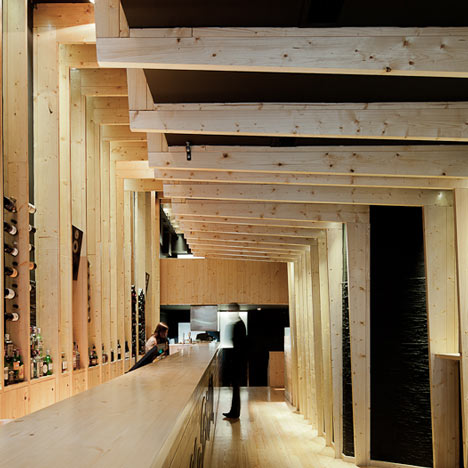Ribbed timber framework folds around the walls and ceiling of this bar in Porto by Portuguese studio AVA Architects (photos by José Campos).
The three floors of La Bohème include a first-floor mezzanine and a basement.
The walls between the wooden ribs are painted black, while all furniture is made from wood and black fabric.
We also recently published a lime green school by AVA architects - take a look here.
Here's a longer project description from the architects:
Bar “La Bohème entre amis”, Oporto - Portugal
The Bar "La Bohème" (entre amis) is located in the “Galeria de Paris” street, amidst the downtown area of Porto.
The redesign sought to implement and structuralize the space, creating its own identity.
The solution was formalized through the texture and the colour of the wood, which defines the space and provides depth to the structure’s design.
This structure, which was placed along the corridors and namely at the walls and ceiling, allows to subvert the whole appearance of the space, appealing to its visitors sense of discovery.
The bar spans three levels: the main floor, basement and a mezzanine.
The latter establishes a visual relationship with the main floor.
The bar counter is located at the main floor’s bigger span, next to the entrance door and public access.
The previously adopted functional solution was maintained, although we opted to change the (only) existing counter’s location in order to give it a larger dimension, functionality and space for its customers.
The involving wooden structure was maintained on the lower level (basement) as to create uniformity with the main floor, and a large wine showcase was added.
The building's facade is clad in granite ashlar.
We assumed that the previous window frames were made of solid wood, as to the resemblance of some existing adjacent buildings.
Changes made to the facade were solely at the level of framework and entrance span, combining an “Afizélia” wood (natural colour) with colourless laminated glass.
The proposed functional solution seemed more appropriate for the establishment’s new areas of operation and organization.
The composition and design of the elements in the framework were formulated taking into account the interior design of the space, while introducing rhythm by drawing vertical uprights.
This also ensured some security, preventing the installation of security systems previously installed.

